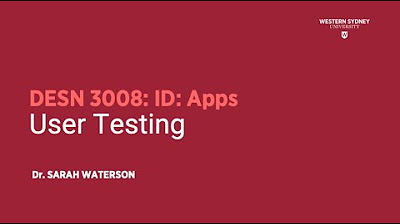Steering Law for Cursor and Mouse Movements in a GUI Tunnel
Summary
TLDRThe video script discusses the challenges of cascading menus in usability testing, highlighting the Steering Law as the reason behind user frustration. It explains how precise movements are difficult for humans, leading to slower navigation. To improve interface design, the script advises increasing space around menu items and introducing a delay before opening subcategories to ensure deliberate actions, ultimately avoiding user frustration.
Takeaways
- 😕 **Cascading Menu Frustration**: Users often struggle with cascading menus due to their complexity and precision requirements.
- 📚 **Steering Law Introduction**: The Steering Law, also known as the Accot-Zhai law, provides a model to predict how users interact with pointing devices.
- 🕹️ **Predictive Model**: The law predicts the time and accuracy required to navigate through a 2D tunnel, representing the user's interaction with a menu.
- 📏 **Key Variables**: The time to travel and the width of the tunnel are critical variables affecting user interaction with menus.
- 🚦 **Human Limitations**: Humans naturally move in curves, making it difficult to move a mouse in a perfectly straight line.
- 🕒 **Time and Precision**: Narrower tunnels in menus require more time and precision, leading to user frustration if not designed properly.
- 🔗 **Practical Design Implications**: Designers should add more space around menu items to reduce the need for precise movements.
- 🛑 **Hover Delay**: Introducing a delay before opening submenus can prevent accidental activation and ensure deliberate user actions.
- 🧠 **HCI Laws Importance**: Keeping human-computer interaction laws in mind is crucial for creating interfaces that are user-friendly.
- 🚀 **Avoiding Frustration**: By applying principles like the Steering Law, designers can avoid creating frustrating user experiences.
Q & A
What is a cascading menu?
-A cascading menu is a type of navigation interface found on websites and apps where submenus are revealed as users hover over or click on main menu items.
Why are cascading menus frustrating for users?
-Cascading menus can be frustrating because they often require precise hovering over small target areas to reveal submenus, which can be difficult and time-consuming.
What is the Steering Law in human-computer interaction?
-The Steering Law, also known as the Accot-Zhai law, is a predictive model that estimates how quickly a user can accurately move a pointing device, like a mouse, through a 2-dimensional tunnel on a screen.
What variables are most important in the Steering Law equation?
-The most important variables in the Steering Law equation are the time to travel through the tunnel and the width of the tunnel.
How does the natural movement of our arms affect the use of a mouse?
-Our arms naturally move in curves, making it difficult to move a mouse in a perfectly straight line, which is often required when navigating through narrow tunnels in a cascading menu.
What does the Steering Law predict about moving through a complex menu?
-The Steering Law predicts that moving through a complex menu with narrow tunnels (submenus) takes more time and is less accurate if attempted quickly.
How can interface designers apply the Steering Law to improve usability?
-Designers can apply the Steering Law by adding more space around menu items, which reduces the need for precise movements and makes navigation easier and faster.
What is the practical implication of the Steering Law for menu design?
-Practically, the Steering Law suggests that menus should have larger targets and possibly a delay before submenus open to ensure the user's action was deliberate.
Why is it important to consider human-computer interaction laws when designing interfaces?
-Considering human-computer interaction laws helps designers create interfaces that are more intuitive and less frustrating for users, leading to better user experiences.
What is the significance of the Steering Law in avoiding user frustration?
-The Steering Law is significant because understanding and applying its principles can help designers create interfaces that are easier to navigate, reducing user frustration.
Can you provide an example of how to improve a cascading menu based on the Steering Law?
-An example of improving a cascading menu based on the Steering Law would be to increase the size of the menu items or the delay before submenus open, making it easier for users to accurately select their desired option.
Outlines

Этот раздел доступен только подписчикам платных тарифов. Пожалуйста, перейдите на платный тариф для доступа.
Перейти на платный тарифMindmap

Этот раздел доступен только подписчикам платных тарифов. Пожалуйста, перейдите на платный тариф для доступа.
Перейти на платный тарифKeywords

Этот раздел доступен только подписчикам платных тарифов. Пожалуйста, перейдите на платный тариф для доступа.
Перейти на платный тарифHighlights

Этот раздел доступен только подписчикам платных тарифов. Пожалуйста, перейдите на платный тариф для доступа.
Перейти на платный тарифTranscripts

Этот раздел доступен только подписчикам платных тарифов. Пожалуйста, перейдите на платный тариф для доступа.
Перейти на платный тариф5.0 / 5 (0 votes)






